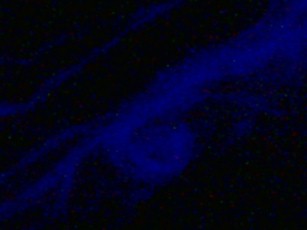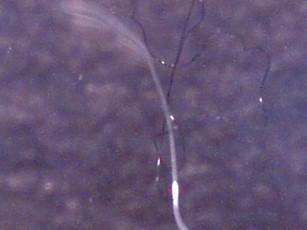ULTRAVIOLET LIGHT INVESTIGATIONS
Original Ground Sample Received Nov 1999. Shown under microscope, top lit stage 60x. Described previously and as delivered certified mail to U.S. Environmental Protection Agency. Distinguishing characteristics : sub-micron in diameter, adhesive, elastic. Remains chemically unidentified.
Original Ground Sample Received Nov 1999 under black light (UV) and microscope (60x). Level of fluorescence is NOT especially notable with this material. Distinguishing characteristics are adhesiveness, microscopic wave forms, and sub-micron diameter of individual fibers.
A common synthetic fiber (type unidentified) photographed under the microscope with visible light at 60x.
The same synthetic fiber shown above under the microscope at 60x, illuminated with black light (UV). Extreme fluorescence, but bears no similarities to earlier ground sample. Fiber diameter significantly greater than 1 micron, and by all appearances one of thousands of similar fibers (i.e., lint) in this residential environment.
Another synthetic fiber with notable fluorescence under the black light. Microscopic photograph taken
with visible light at 60x.
The same synthetic fiber shown above under the microscope at 60x, illuminated with black light (UV). Extreme fluorescence, but bears no similarities to earlier ground sample. Fiber diameter significantly greater than 1 micron, and by all appearances one of thousands of similar fibers (i.e., lint) in this residential environment.
In addition, several fibers which appear to be of cotton also exhibited marked fluorescence under the black light. These were also examined under the microscope and also did not exhibit any of the unusual characteristics of the ground sample referenced earlier.
Allowance is made for the fact that the material emitted from active aircraft could be highly variable. Caution is advised in the meantime, however, of using UV fluorescence as an identifying characteristic. More data must be made available to assist in the process of identification, such as microscopic photographs. Also consider the presentation of chemical testing previously described in order to make further comparisons of materials. Although hundreds to thousands of fluorescent fibers under the black light (UV) have been identified locally under this preliminary investigation, none of them have been found to be of an especially unique nature.
Additional data and feedback of the current investigations underway with UV light is most welcome. Hopefully these can be accompanied with some level of microscopic and or chemical evaluations. Thank you.
Clifford E Carnicom April 17 2000









